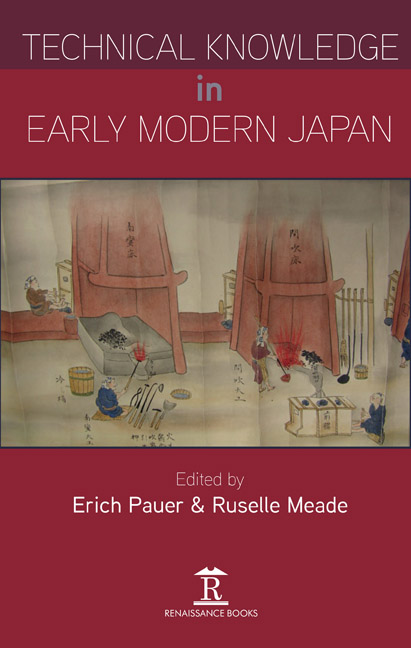Book contents
- Frontmatter
- Contents
- Acknowledgements
- Introduction: Remarks on the History of Technology in Japan
- 1 Production Techniques in Early Modern Japan as seen through ‘Famous Products of Japan from Mountain and Sea, Illustrated’ (Nippon sankai meisan zue, 1799)
- 2 Vehicles of Knowledge: Japanese Technical Drawings in the Pre-modern Era, 1600–1868
- 3 Dissemination of Knowledge and Technology: The Extensive Range of Exhibitions in Japan in the Eighteenth and Nineteenth Centuries
- 4 Knowledge on Mining and Smelting and Its Dissemination in the Edo Period
- 5 Tanaka Hisashige and His Myriad Year Clock: Its Technological Characteristics and Historical Background
- 6 A Statistical Analysis of Tōkyō Meikō Kagami (with a Focus on Highly Skilled Metalwork Craftsmen)
- 7 Boiler Manufacture in Late-nineteenth Century Japan: From First Beginnings to Nationwide Expansion
- Appendix: Selected Sources on the Japanese History of Technology (especially on series)
- List of Contributors
- Index
5 - Tanaka Hisashige and His Myriad Year Clock: Its Technological Characteristics and Historical Background
Published online by Cambridge University Press: 30 April 2022
- Frontmatter
- Contents
- Acknowledgements
- Introduction: Remarks on the History of Technology in Japan
- 1 Production Techniques in Early Modern Japan as seen through ‘Famous Products of Japan from Mountain and Sea, Illustrated’ (Nippon sankai meisan zue, 1799)
- 2 Vehicles of Knowledge: Japanese Technical Drawings in the Pre-modern Era, 1600–1868
- 3 Dissemination of Knowledge and Technology: The Extensive Range of Exhibitions in Japan in the Eighteenth and Nineteenth Centuries
- 4 Knowledge on Mining and Smelting and Its Dissemination in the Edo Period
- 5 Tanaka Hisashige and His Myriad Year Clock: Its Technological Characteristics and Historical Background
- 6 A Statistical Analysis of Tōkyō Meikō Kagami (with a Focus on Highly Skilled Metalwork Craftsmen)
- 7 Boiler Manufacture in Late-nineteenth Century Japan: From First Beginnings to Nationwide Expansion
- Appendix: Selected Sources on the Japanese History of Technology (especially on series)
- List of Contributors
- Index
Summary
INTRODUCTION
TANAKA HISASHIGE IS well known today for his various ingenious inventions and for his construction of useful or entertaining machines, particularly his contrived automata dolls (karakuri ningyō). He is also known for his later involvement in the modernizing attempts of the Saga domain (present-day Saga prefecture) and as one of the founders of the company that is now Toshiba. He should also be remembered as the craftsman who designed and made the intricate machine called the ‘Myriad Year Clock’ (Fig. 1), or Mannen dokei, a masterpiece of Japanese craftsmanship, before the systematic introduction of Western technologies.
In this paper, I explain the mechanical structure and technological characteristics of this mechanical masterpiece based on my experience and from information acquired during a project to disassemble and restore the clock. I first provide a short biography of Hisashige, as well as a brief explanation of the project of disassembling the clock. I then explain the basic structure of the Myriad Year Clock together with technological features observed by the engineers engaged in the disassembling and restoration project.
A BIOGRAPHY OF TANAKA HISASHIGE
Tanaka Hisashige, originally named Tanaka Giemon, was born in 1799 as the eldest son of a tortoiseshell craftsman. Early in his childhood, he showed mechanical ingenuity in making devices, some of which were useful to his neighbours. At the age of eighteen, his father passed away. Although he was expected to succeed his father's position, he conceded it to his younger brother, deciding instead to become an inventor. Thereafter, he devised numerous entertaining automata, including a teacup-carrying doll, an arrow-shooting doll, and a doll that wrote Chinese characters. He displayed them at shrines or other public spaces, a common practice in various cities in Japan since the late eighteenth century.
Thereafter, Hisashige travelled widely around western Japan, eventually settling in Ōsaka and then Kyōto where he opened a shop to make various machines. At the Kyōto shop, he also started to repair damaged clocks, and this business turned out to be a success. In addition, he invented a new type of oil lamp with a glass shade, as well as a pressurized pump to supply oil from below. The two contrivances made the lamp's illumination brighter and more stable than traditional candle lamps.
- Type
- Chapter
- Information
- Technical Knowledge in Early Modern Japan , pp. 96 - 128Publisher: Amsterdam University PressPrint publication year: 2020



